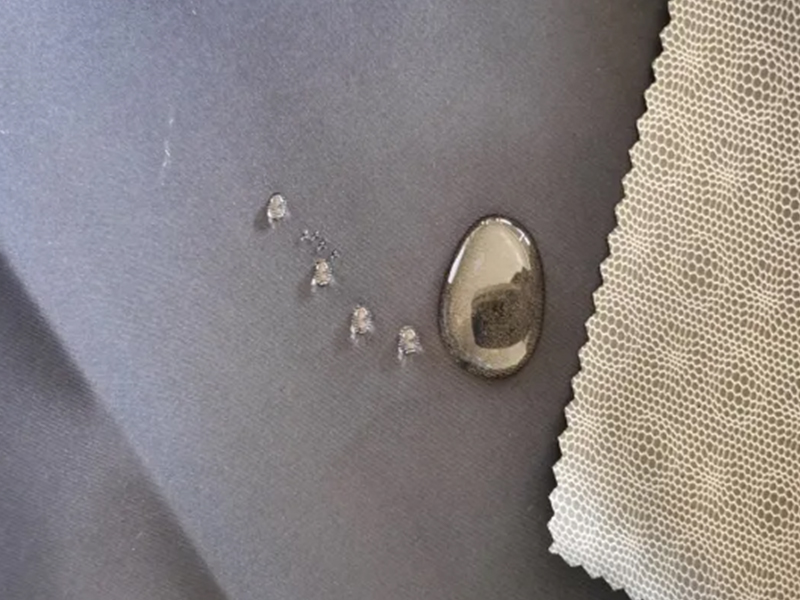A
raincoat is a rainproof garment made of waterproof fabric. Practical waterproof fabrics for raincoats include tape, tarpaulin and plastic film. Modern raincoat waterproof fabrics pay attention to breathability, commonly used such as special nylon and Gore-Tex. The breathable raincoat is conducive to the release of hot and humid water vapor from the raincoat when people wear rain protection, adding comfort. So do you know what kind of fabrics are used for raincoats?

Polytetrafluoroethylene (PTFE) waterproof and breathable laminated fabric is an adhesive using special beads, which is composed of PTFE microporous film and ordinary fabric through a lamination process. The fabric has excellent waterproof and breathable functions and windproof and warm properties. It not only has outstanding functions, but also has a wide range of practical applications, flexible design, and less pollution. Structure of Laminated Fabrics Laminated fabrics can take different structural designs and composite layers according to the needs of the end use. The two-layer lamination can be a combination of fabric and film, using a live surface structure; it can also be a combination of Rico and a film, using a live surface structure, which is easy to clean, and is suitable for civilian activity clothing and cold protection clothing. Three-layer lamination is a combination of fabric, film and Rico. Although it feels slightly harder, it can improve wear resistance and is suitable for team combat uniforms and labor protective clothing. Four-layer or multi-layer composite can add the function of laminated fabric, as gas resistance layer, anti-virus material of liquid resistance layer and far-infrared cotton thermal insulation material. Both facial and rico fabrics should have a certain density to prevent the phenomenon of glue oozing during bonding. To control the total weight of the laminated fabric, face and lining should only use fine denier, superfine denier polyester or nylon. According to the application requirements, the facial mask can also use functional fabrics such as camouflage, flame retardant, anti-static, oil- and water-repellent, easy to remove, and acid and alkali resistance.
The use of waterproof and breathable fabrics
PTFF waterproof breathable laminated fabric was first developed for the production of dresses and protective clothing, and later used for active wear. The manufacture of tents and other items is still expanding in the field of use. For Air Force pilots, navy soldiers and special forces, the drop in body temperature caused by sudden immersion in cold water is one of the tense factors that cause casualties. The U.S. military has made waterproof and breathable clothing for Air Force pilots. Special riot gear for seamen and special forces who conduct sea, land and air operations. These garments provide up to 2 hours of protection in cold water at 7 degrees and are light and comfortable to wear.
The main technical performance requirements of military raincoats are excellent waterproof and breathable performance and light weight. The PTFE microporous composite fabric not only handles the conflict between breathability and waterproofing, but also reduces the weight of the raincoat, thereby effectively reducing the load on soldiers.
Fire suits, woven aramid fabric for face, PTFE for film, warp-knitted aramid knitted fabric for Rico, and phosphorus-containing polyurethane as the caulking agent. Improves the comfort of wearing protective clothing.
Military light tents require rainproof, flame retardant, anti-aging, etc., and PTFE film material has the characteristics of anti-corrosion, strong acid and alkali resistance, and aging resistance, so it can accept PTFE laminated fabric.
Sleeping bags require warmth, breathability, light weight, etc. Based on the characteristics of PTFE microporous film laminated fabrics, a double-layer structure is adopted, the outer layer is nylon fabric, and the inner layer is Pwu FE film. This sleeping bag is used without the risk of hypoxia and carbon monoxide poisoning.
Because PTFE material has extremely different chemical corrosion resistance and flame retardant properties, and the microporous structure of the film makes it more waterproof (liquid) breathable, it has become an ideal material for the development of nuclear, biological and chemical protective clothing.
PTFE waterproof and breathable laminated fabric can not only meet people's wearing needs when exercising in harsh conditions such as severe cold, rain and snow, strong winds, etc., but also be suitable for people's daily life requirements for raincoats, shoes, etc., and has broad application and development prospects.
The focus of the research and development of PTFE waterproof and breathable laminated fabrics in the future is to reduce costs and strive to make the fabrics more lightweight, comfortable and multi-functional.












